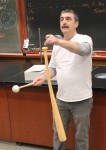
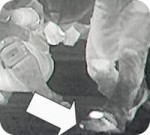
David Kagan, CSU Chico
David shared a rubber bat that he can use to find the “sweet spot.” Contact David for the information of the company that made it for him for $50. It was a movie prop but you have to tell them that you don’t want a dowel in it.
David shared video of a baseball hit at the batter’s footer with a regular video and then with the Fox News Infared camera. The
transfer of energy to the ball from the bat makes the ball hot enough to be bright white. The place where the baseball hit his foot also glows white; amazingly the ball is now only half white. More information is available on his website: www.phys.csuchico.edu/baseball
Frank Cascarano, Foothill College
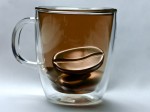
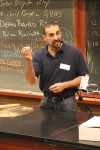
Frank shared a small object called a “Joulie” that has a material in it that melts at 140 degrees. When dropped in hot coffee it absorbed energy to cool your coffee but when your coffee cools below that same temperature it releases energy to the cup of coffee.
Bernard Cleyet, retired
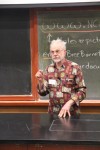
Bernard showed a video of a different glass materials heated and used as a conductor in a simple electrical circuit with a light bulb. The experiment used Sodium glass, pure silica, and Pyrex and plugged into an outlet. Bernard also offered lots of capacitors for anyone who needed some.
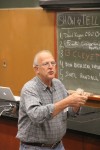
Don Rathjen, Exploratorium Teacher Institute
Don demonstrated a home-made micrometer that will measure one millimeter per rotation. With 24 threads per inch, one turn is ~1mm, but it will measure within 10% error. Can use to measure the width of a hair, different wire gauges, etc. Don will be posting the instructions with photos on his website soon.
Shel Randall, Sierra College
POV Ray is a scripting tool that lets you make images with simple commands. Shel shared a short animation about thin film interference that he has made in the last year. He encouraged everyone to experiment with the animation program for use in their classroom.
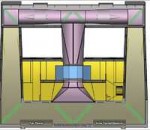
John Boyce, iFly
John is the educational director for iFly in Union City, CA. John gave us a brief introduction of the facility and the science behind it. Field Trips with the program can be organized via John and previewed on the education portionof their website. If you book a field trip by Thanksgiving, you might win a free visit! Be sure to email John directly for more information: johnb@iflysfbay.com
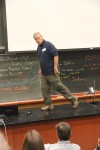
Michael Boykin, GVHS
Michael demonstrated a way of showing a real simple action explained in terms of Physics. He demonstrated how even walking is a complex set of procedural steps. He leads students to the idea that muscles are on the back of the body and the secret is pushing back against the floor in order to be propelled forward which can be related to Newton’s Third Law. Michael reminded us that getting up on the table or doing something silly is always going to get and keep your students’ attention.
Dean Baird, Rio Americano High School
Dean shared his “Scientists Valentines and “Back Masking” which involves playing a song backwards and hearing “secret messages.” Upon first listening, no one can discern any words but when the “secret message” lyrics are shown suddenly everyone can hear it. For more information can be found at www.JeffMilner.com/backmasking.
Bree Barnett Dreyfuss, Amador Valley High School
Bree suggested reading “The Pluto Files” by Neil de Grasse Tyson and using it with an astronomy unit to discuss the scientific process and classification of objects in the solar system. There was a NOVA Special and supporting material online as well.
Bree also previewed her work with Jon Brix on using laboratory notebooks from bound composition books in their Conceptual Physics course. If the experiment is successful this year she plans on offering a workshop at the Spring meeting, April 20 & 21, at Lake Tahoe.
Be sure to like NCNAAPT on Facebook as well!
Gunjan (aka Dr. G)
Dr. G demonstrated her programs that teach Physics to younger students using a volunteer child.
Leanna Felardo, Oroville High School
Leanna asked everyone to bring mystery equipment to the Spring meeting in Tahoe. She will be leading a workshop meant to help identify unknown material and its use. You can also email Leanne with a photo of your mystery equipment at LFelardo@ouhsd.org.
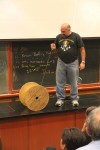
Brian Bellis, Hoover High School
Brian shared how he uses with a large wood spool to demonstrate torque. Brian also demonstrated an optical illusion of a little Red Dragon that he found online and folded up. The eyes of the little red dragon follow you as it moves.
 Joel Rosenberg, Lawrence Hall of Science
Joel Rosenberg, Lawrence Hall of Science
Joel explained the process behind the CELL (Clean Energy Learning and Leadership) program. There is a visual representation of Power as the area of a box with the voltage representing the width and the current representing the height of a rectangle.
Peng Yav, Sebrante, IISME
Peng shared the details of the IISME summer program. Teachers have the opportunity to work in the industry during the summer to gain experience and money. The applications for the summer program are due this month! To learn more about Industry Initiatives for Science and Math Education (IISME) contact:
Shari Liss, Education Director at sliss@iisme.org and (408)553-3179
Christina O’Guinn, Education Manager at coguinn@iisme.org and (408)553-2266
Be First to Comment